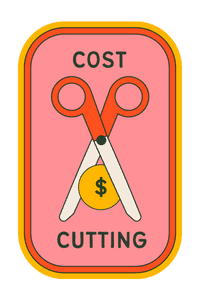So far, 2023 is looking like it could eclipse last year as being the new Year of the Layoff. The economic outlook for 2023 isn’t great: the Federal Reserve is debating driving up already-high interest rates, and previously profitable sectors of the economy such as technology are taking large financial hits, not to mention the new fears of possible bank system failure after the recent collapses of both Silicon Valley Bank and Signature Bank. In the wake of all of this economic turmoil, many organizations may be bracing for a possible recession or economic downturn and considering taking proactive action by implementing job freezes or reducing their workforce. Layoffs may in fact be the right choice for some companies, but in order to remain productive, organizations need to be strategic both in implementing layoffs and in shoring up support systems for remaining employees after job cuts have been made.
Layoffs in 2023 So far
2023 layoffs have started off at a brisk pace. The New York Times reports that 1.7 million people were laid off in January 2023, the largest number of layoffs in a single month in almost three years. The U.S. Bureau of Labor Statistics has not yet released official data addressing February layoffs, but a LinkedIn rundown of information compiled from news sources and employee postings demonstrates that layoffs continued in the second month of 2023 as well, with the tech, crypto, banking, retail, and media sectors being hit particularly hard. Notable organizations laying off employees in February 2023 included:
• Tech companies: Zoom, Twitter, Palantir, and Divvy Homes
• Crypto companies: Polygon and CoinTracker
• Banking organizations: Wells Fargo, JPMorgan Chase, and Bank of America
• Retail companies: Poshmark, eBay, and The RealReal
• Media and entertainment organizations: Disney, NewsCorp, and NPR
• Other big corporate names: BarkBox, GoDaddy, Affirm, and Geico
Layoffs have continued into March. LinkedIn’s March 2023 layoff rundown notes that the trend of layoffs in the tech industry shows no signs of letting up, with the biggest headline being another round of layoffs at Meta, Facebook’s parent company, which is following up a 13% reduction of its workforce implemented in November 2022 with another round of layoffs reportedly reducing its staff by an additional 10,000 people. Other notable companies in the tech space announcing March 2023 layoffs include:
• Y Combinator, the famous startup accelerator responsible for helping to launch Reddit, Dropbox, Stripe, DoorDash, and Instacart, among others
• Waymo and Everyday Robots, both subsidiaries of Google’s parent company Alphabet
• The AI startup Yellow.ai and the short-term rentals startup Sonder
The crypto, retail, and media industries also continue to make workforce reductions, with Silvergate, Sirius XM, and Hunter Douglas as notable examples. Other big names implementing layoffs in March 2023 include Krispy Kreme, the San Francisco 49ers, Tyson Foods, Johnson & Johnson, Clif Bar & Co., UKG, Atlassian, MasterClass, AirBnB, Citigroup, and Evernote.
During a time of widespread layoffs and economic downturn, the key to maintaining the smooth functioning of your organization lies in your approach to managing these adverse circumstances. Collaboration tools like LEAD.bot emerge as the saviors in this critical juncture. They not only facilitate better communication and coordination among the remaining staff but also help in keeping the morale high during challenging times. When a team member is let go, the remaining employees may feel anxious and disconnected. By fostering connections and encouraging communication between the remaining team members, LEAD.bot can create a more unified, collaborative work environment, thereby easing the transition during layoffs.
Where will the next round of 2023 layoffs hit?
It is always difficult to predict exactly what industry or which organization will next feel the need to cut costs by reducing their staff. However, it is likely a safe bet to anticipate more layoffs in the tech industry, particularly following the collapse of Silicon Valley Bank, a major investor and backer of more risky tech startup organizations. Similarly, because of potential concerns around the stability of the banking system, we may see other regional and possibly even national banks begin to lose access to some of their customer assets and be forced to lay off workers as a result.
Recent reports that people are reducing the number of streaming services they subscribe to may indicate that the 2023 layoff trend will migrate to the entertainment industry next. As inflation stubbornly persists, consumers are likely to pay more attention to their discretionary spending, meaning they may be less willing to spend money on travel. This trend, combined with the recent safety- and customer service-related struggles the airline industry has been experiencing, could lead to layoffs at large airline companies (although, it should be noted that many of those companies have also been struggling with staffing issues, so it’s possible layoffs will not be their first choice when it comes to cost-cutting measures).
Impact of layoffs on individual employees
Layoffs are never fun for an organization, and the people perhaps hit the hardest by such a dramatic workforce change are the employees remaining after job cuts are complete, who may feel increasingly at risk. If you have just watched your colleagues lose their jobs, it is natural to fear that you will be next – and such fear can have significantly detrimental impacts on employee health and well-being, and consequently employees’ productivity and engagement levels.
As the BBC reports, layoffs in 2023 are occurring in a particularly unique working environment. During the pandemic, employers began to recognize the value of prioritizing employee mental health and happiness levels at work, and as a result, many companies developed a culture of employee engagement, including wellness programs and a focus on enhancing the overall employee experience. If a company that professes to care about all aspects of employee wellbeing suddenly lays a large number of its employees off, that action can stand in sharp contrast to their earlier statements about valuing and supporting their staff. Regardless of how well mass layoffs are executed, widespread job cuts communicate to a company’s employees that they are disposable, which can negatively impact employee trust in an organization and lead to employees believing the company leadership’s claims of prioritizing employee engagement were empty and inauthentic promises.
Why vendor cost-cutting after layoffs isn’t worth the money
Two of the most concrete steps towards building employee loyalty to an organization and improving employee well-being are increasing employee collaboration and decreasing employee isolation. Simply put, employees work better when the overall workload is evenly dispersed across an entire organization (increased collaboration), and when they work with people they care about and have strong relationships with (decreased isolation).
In today’s increasingly remote workplaces, maximizing collaboration and minimizing isolation can already be a complicated proposition. If a company with a distributed workforce has just undergone a round of job cuts and reduced its employee headcount, its remaining employees are at an even higher risk of feeling disconnected from their employer. Increasing connections between employees through the use of employee engagement programs and software can be one of the most effective ways of preemptively staving off the negative shifts in employee attitudes that can accompany layoffs.
Even if your organization has not participated in the 2023 layoff wave, it can still be a crucial time to invest in employee well-being. With the publicity around layoffs, particularly the recent job cuts in the tech industry and at prominent organizations, employees may be feeling a little skittish about their job security even if no such downsizing has happened at their organization.
It’s normal for business leaders to be feeling a little nervous about their company’s future as well. Often, during times of economic turmoil, company leadership may be looking for additional ways to save money, even if the organization has not yet had to engage in downsizing. In the face of an economic downturn, enhancing employee engagement becomes even more critical. A higher level of engagement results in increased productivity, improved employee morale, and a greater sense of loyalty towards the organization. It’s important to understand that the process of enhancing engagement starts with empathy. In a challenging economic climate, employees appreciate when their employers show understanding and flexibility. This is where collaboration tools, like LEAD.bot, can play a pivotal role. With features that promote regular interaction, prompt discussions on various topics, and build relationships, these tools can effectively nurture an engaging environment. Furthermore, by facilitating open communication channels, they can help the employees feel heard and valued, thereby promoting a sense of psychological safety and job security. Cost-cutting procedures could include critically examining and restructuring other aspects of organizational budgets and operations, including products and programs related to employee engagement. Because such expenses are often viewed as “nice-to-haves” by organizational leadership, costs related to employee experience are often the first on the chopping block.
However, eliminating employee engagement programs is likely to have the exact opposite effect: instead of saving the company money, pulling back investments in the employee experience can lead to higher levels of employee burnout and attrition, ultimately costing the organization far more in turnover, recruitment, and training expenses. Cutting costs for employee engagement tools is simply not sustainable for your organization’s future.
How collaboration tools will strengthen your organization in the long run
Collaboration and employee engagement tools such as LEAD.bot are essential to ensuring your employees remain engaged with your organization after a round of layoffs. By intentionally building connection opportunities into tools your employees are already using, such as Slack and Microsoft Teams, you can communicate with your people – your most valuable asset! – that even though times may be tough economically, your company is still prioritizing the employee experience.

Increase productivity
LEAD.bot can automatically match employees for connection across teams or work areas, which can be especially helpful if your organization has just undergone a workforce reduction, and employees may have abruptly lost connection with valued colleagues. As a bonus, increasing communication across different functional areas in your organization has the added benefit of also increasing productivity. As The Wall Street Journal reports, research has demonstrated that when employees learn about how others have been positively impacted by their work, even through interaction as short as a five-minute conversation, their production output nearly doubles. Connecting an engineer to a customer service rep who can explain how the engineer’s innovations made it easier for them to help customers can help the engineer find more of a sense of meaning in their work and be more motivated to make further innovations in the future. LEAD.bot makes those conversations happen.
Even when not talking directly about work, increased interaction between employees is a net positive for an organization. Research from Gallup indicates that when an employee has a colleague they consider to be a “best work friend,” they speak up and share their ideas with others more often, their workflow becomes more efficient, and, perhaps most important of all, they are more likely to report that their workplace is a “fun” place to be. Broadening your employees’ networks through the use of collaboration tools such as LEAD.bot increases the probability that your employees will find a colleague they connect with on a deeper level, with high potential productivity and employee loyalty benefits for your organization.
Create psychological safety
Research also indicates that for a truly successful workplace culture, psychological safety needs to be paramount. Psychological safety has been defined in organizational culture literature as a “shared belief held by members of a team that the team is safe for interpersonal risk-taking.” Moreover, amidst an economic downturn, a company’s capacity to innovate and adapt becomes crucial for survival. By maintaining high levels of engagement, companies can keep the creative and innovative energies of their employees alive. Collaboration tools help in creating a space where ideas can be shared freely without fear of criticism or judgment. LEAD.bot’s platform allows employees to connect across teams and work areas, sparking collaborations that may lead to groundbreaking ideas and solutions. In this way, managing layoffs effectively with collaboration tools and focusing on enhancing employee engagement could prove to be the difference between merely surviving an economic downturn and thriving in the midst of it. If an organization has just undergone a round of job cuts, the remaining employees are less likely to feel psychologically safe in their workplace as they may be uncertain about their own employment future.
If employees have an increased sense of job insecurity and a worry that their position might be the next to be cut, they are not going to want to draw attention to themselves. This fear of vulnerability may mean they are less likely to suggest new projects that could be considered risky or to push back on decisions and suggestions they don’t agree with. When employees don’t feel comfortable sharing all of their thoughts and ideas, creativity and innovation at an organization suffer. Additionally, research demonstrates that employees who do not feel psychologically safe in their workplace will take 43% more sick days, meaning psychological safety has a direct relationship to employee productivity.
LEAD.bot increases psychological safety in an organization by fostering relationships and authentic connections among employees. These connections can be built on lighthearted conversations, such as those found in LEAD.bot’s 100+ Watercooler topics/personalize your own topics to start get-to-know-you discussions on Slack or Teams channels, including prompts such as “If you could have any superpower, what would it be?” Or, you can use LEAD.bot to foster psychological safety within your teams on a deeper level via LEAD.bot’s diversity, equality, and inclusion integration, which can spark discussion on topics including allyship, sense of belonging, inclusivity, and unconscious bias in the workplace. LEAD.bot’s conscious collaboration and connection opportunities are the best way to communicate to your employees that, no matter what the economic outlook and regardless of any layoffs, your company recognizes the value of employee relationships and experiences and will continue to prioritize employee engagement in the future.
Use LEAD.bot post-layoffs to help your remaining employees
Whether your organization has already laid workers off, or your employees are nervously watching as the #OpenToWork posts pile up on their LinkedIn feeds, investing in employee connection is more important now than it has ever been before. LEAD.bot, with its automated employee-pairing system, takes the work out of fostering engaging company culture. You can even use LEAD.bot to take building employee relationships a step further by implementing not just simple work-related check-in conversations, but also mentorship matching programs, or virtual coffee breaks. Use LEAD.bot to boost your employees’ productivity and help them feel more connected to their colleagues and your company, no matter how uncertain the economy may feel.


